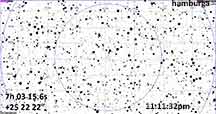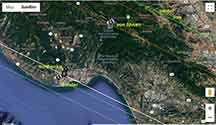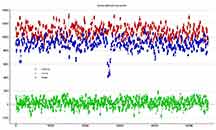


This is a high rank event by a name asteroid Hamburga and it goes through Santa Cruz with good confidence. Centerline is near Karl. Kirk and I closer to the southern limit. Going to UCSC won't affect spacing, but going NE (e.g. Rodeo Gulch) will aid spacing. However, given the likely poor timing accuracy, I'm not convinced the science value warrants big spacing efforts. Karl's timings will matter, though.
 |
 |
 |
I observed from the driveway near the mailboxes, and got a good positive. Easy to see by eye on the monitor, and looked deeper than 0.6 magnitude. Recorded at 8x. However, the recording suffered unusual noise. Or photometric measuring noise... it's still unclear why. However, a 2nd analysis was successful, using different decisions in PyMovie and PyOTE on the same raw video.
Richard Nolthenius
I had the dreaded "bars" on play back of my previous asteroid recording, which cleared up when recharging the camcorder. Before this event, I made sure it was fully charged. I also ran (for the first time) a DV cleaning tape just once for the recommended 10s duration. When I first powered up for the occultation, I could see strong vertical banding, and also that the vertical bands that were brightest were grouped into widely separated groups, maybe 5 groups across the width of the chip. It looked very much like the RFI noise I'd seen when doing the Zooniverse SETI project with my students a week earlier. Was their radio noise from somewhere? Was it coming from my own equipment?? Everything I believe is powered by 12DC and there's no AC involved. Still, I could hear what sounded like 60cycle 'hum' on the audio even though I had set the mic power to zero.
I saw strong ~2.1s periodic .5 magnitude oscillations in the brightest tracking star. Not so obvious in the dimmer stars, but there was still brightness noise that is frustrating the ability to pass the FP test. This is my reductions with PyMovie 3.7.3, Using the fainter tracking star as reference, with only a 2 integration smoothing length to track the oscillations. It seemed to give the best S/N, but still did not pass the FP test. I used 4.5px static aperture, and 2 tracking stars. The second tracking star used for ref, was also static and same px size.
 |
The occultation is there, but so are lots of false dips, and the magnitude drop is muted too. It's just not getting the photometry correctly. See 2nd analysis below... |
 |
 |
 |
Fails the false positive test, due to other oscillations and reduced depth of measured drop of actual occultation. |
Second analysis for Nolthenius - PyOTE Log file
This time, I tried "snap to blob" for the target and also set it as a tracking aperture. I also set a very nearby star of similar brightness as "ref" and static aperture, and a sky aperture. This time, the bizarre modulation is missing pretty much, and the data look pretty good, and solid pass for the False Positive test. This is still using PyMovie ver 3.7.3
|
Target is the left yellow box, blank sky is beneath, and the 'ref' star is at right. Yellow tracking for both target and ref. The aperture below is the 'snap to blob' of the target |
This time, the curves are all quieter, even though the 'ref' star was the same static aperture size on the same raw recording as the first analysis. The target star and occultation stand out clearly without the oscillations of the first analysis. |
'ref' star light curve in PyMovie. The scatter is much improved from the first analysis, even though it was a static tracking aperture, just as was the first analysis (but 1st analysis used a different star farther from the target). A mystery why this was quieter. |
Target star in PyMovie. The oscillations of the first analysis are mostly gone and the amplitude of the occultation is deeper and correctly measured at 0.61 magnitudes as predicted. |
This time, the False Positive test is passed easily. |
|
PyOTE reduction. |
And, zoomed in. A 3.8 sec occultation. |
There was only a single integration which had PyMovie switch to the static aperture. It does not look to me like it affected the accuracy of the photometry, although it did occur right at the end of the occultation. Bob Anderson agrees that the static aperture switch does not affect the timings. |
Kirk Bender - PyOTE Log file
Observed from home, got a recording at 32x. Solid data; best of the 3 successful observers in "Team Santa Cruz". A 3.04 second event. Not much explaining to do.
 |
 |
 |
 |
 |
Karl von Ahnen - PyOTE Log file
Karl got a good recording and a solid positive, for this faint 14.3 magnitude star behind the 13th magnitude asteroid. I reduced the tape using 'snap to blob' for several similar stars to use as references, as there seemed to be a cycle. It looks like the trip suffered a bump or there was a wind jog twice during the early taping. Did not affect the area around the occultation. When I did a first reduction, I also saw a slow wave in the data, comparable to ~1/2 magnitude. This and the wind shakes caused a failure of the False Positive test. I saw the same wave in the light curves of the other stars and so I used them for 'reference' and this gave a good flat unocculted trend for the target star, and enabled a good FP test.
|
Composite of all light curves. Each star was dynamic aperture'd and 'snap to' and left to independently follow their targets, rather than slave them to move (i.e. I didn't specify them as tracking apertures. |
target star+asteroid light curve |
In PyOTE, I tried each of the 3 reference stars as reference, with minimum smoothing to get the short ~1/2s wind or tripod bumps. I also trimmed off the end of the tape, where there was another bump and end of observing |
The wind/tripod bump was trimmed off of this segment. |
The occultation occured at the expected time, and 4.9s long, as expected vs the 3.8s for Kirk and my events. |
|
False positive test passed OK. |
Summary:
So, Karl's 4.8s event, my 3.8s event, and Kirk's 3.1 s event are consistent with the separation from the centerline, perhaps with a north shift of maybe 10%.